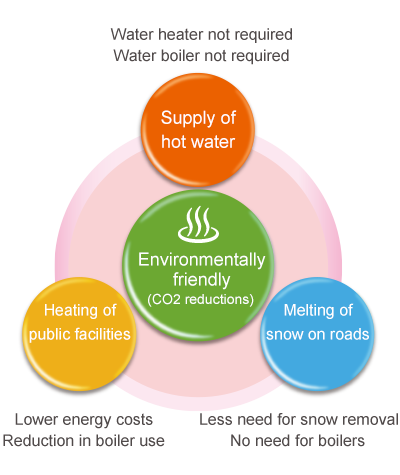
We support the Sustainable Development Goals (SDGs).
Sustainable tourism in Kusatsu
Kusatsu's hot springs are the blessings of the earth and property of the natural world.
We aim to use our hot spring assets in a sustainable manner.
Hot spring initiatives

Kusatsu Onsen's environmental initiatives
Sustainable and environmentally-friendly initiatives have a long history in Kusatsu. For example, an energy-saving hot water supply system, which requires no boilers, is used to provide hot spring water at the right bathing temperature to facilities and hotels, while hot tap water is also supplied to homes and businesses. This is achieved by exchanging heat between the pipes that carry the extremely hot spring water and the standard water pipes. Furthermore, snow on the road is melted during winter by running warm water and used hot spring water from bathhouses into pipes laid under the road. The hot spring water in Kusatsu is not only good for the environment, but it keeps the town and its people warm.
Annual CO2 reductions of 15,721t
(calculated according to Ministry of Environment's guidelines for assessing total emissions)


Steps are being taken to return the Yukawa River to a habitable environment for fish by adding natural lime to neutralize the water because used hot spring water from all of the facilities in the town used to flow into the river. Given the precious nature of our hot springs, we need to use them properly. This is just another facet of Kusatsu's "onsenism."
Other initiatives

Over the course of its long history, the people of Kusatsu have continued to develop the town's unique hot spring culture all the while placing much importance on a framework for its streetscape. Efforts have focused on future-oriented town planning mainly with the formulation of streetscape guidelines that recommend the use of timber and natural materials, as well as the establishment of guidelines for supervising large-scale construction or other activities that alter the landscape.
Kusatsu's landscaping principles
- Inheriting and developing hot spring culture and town history
- Shaping the landscape to nature's advantage
- Creating lively spaces that are fun to stroll around
- Having the townspeople take the lead in town planning

The Yoshigadaira Wetlands are registered as an official site under the Ramsar Convention on Wetlands because of the internationally significant ecosystem that is home to numerous alpine plants, the Japanese serow (a species designated for special protection), and the forest green tree frog (a species endemic to Japan). Also, a mountainous area that straddles Yamanouchi (Nagano Prefecture), Kusatsu, Nakanojo, and Tsumagoi (Gunma Prefecture) has also been designated by UNESCO as the Shiga Highland Biosphere Reserve.
Also, it is hard to think that any plants could grow in the sulfuric and acidic soil and the high temperatures of Kusatsu's hot spring water, but there is a class of algae called Cyanidiophyceae that thrive in this particular environment. It is a rare and primitive algae found in places such as the Americas, Italy, and Indonesia, but in Japan it grows predominantly in Kusatsu. This vividly green algae can be seen in the Yubatake and at Sainokawara.
